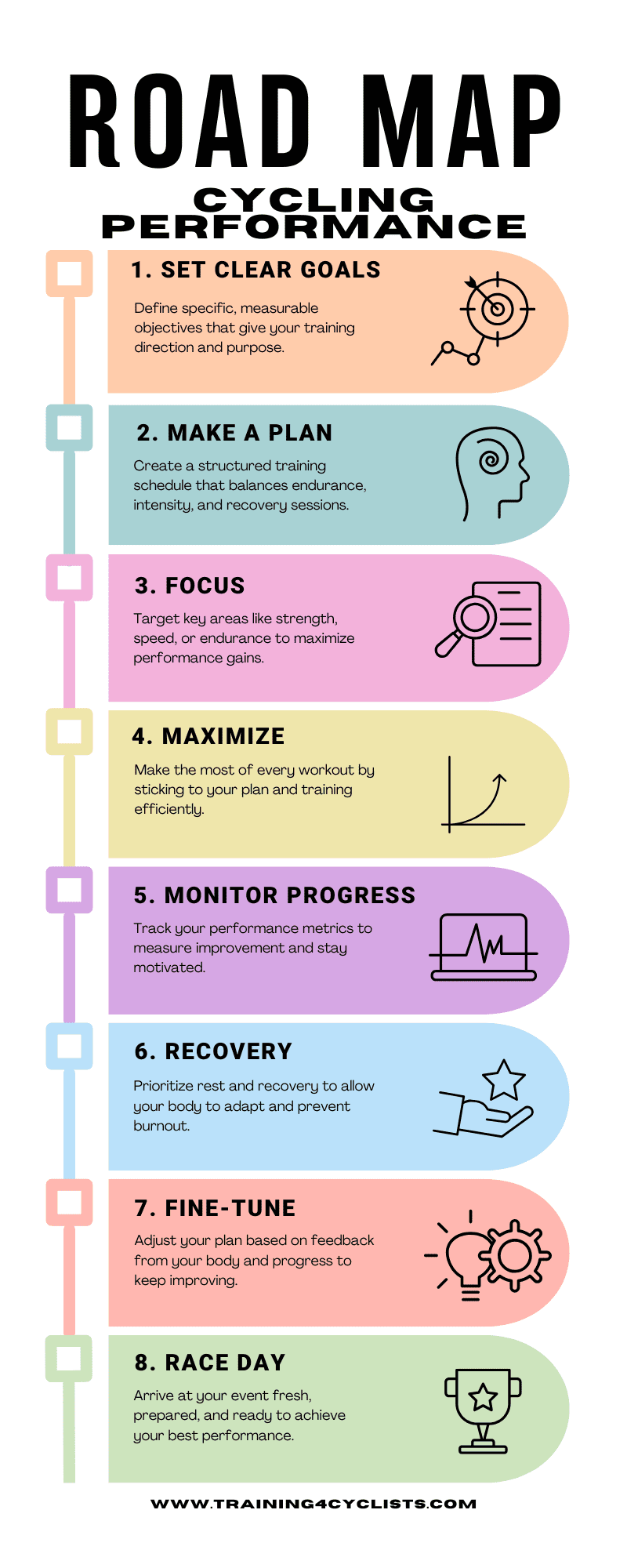Every rider—from the weekend warrior to the seasoned pro—wants to improve in the cycling world. We all dream of riding faster, longer, and stronger. But achieving consistent progress isn’t just about riding more miles or pushing yourself harder; it’s about riding smarter. That’s where structured training comes in.
Imagine setting off on a long road trip without a map or GPS. You might have a general sense of direction, but without a clear route, it’s easy to get lost, take wrong turns, or waste time on detours. The same is true for your cycling training. You need a roadmap—a structured training plan—that guides your efforts, helping you make the most of your time and energy while ensuring steady, measurable progress toward your goals.
In this post, we’ll dive into why having a structured training plan is crucial for your cycling performance and how it can help you achieve peak results. I’ve seen so many riders improve their performances simply by adding structure to their training. So keep reading.

What Is Structured Training?
Structured training is about more than just deciding to ride on certain days of the week or pushing hard when you feel like it. It’s a purposeful approach that organizes your workouts to maximize efficiency and performance. Each ride in a structured plan has a specific goal: building endurance, improving power, or focusing on recovery.
A well-structured training plan ensures that every workout fits into a bigger picture, helping you progressively build fitness while avoiding burnout, overtraining, or injury. It includes a balance of endurance rides, high-intensity interval training, recovery sessions, and tapering phases leading up to race day.
Why Structured Training Matters
1. Maximize Your Time and Effort
Let’s face it—most of us have busy lives. Finding time to ride can be a challenge between work, family, and other commitments. A structured training plan allows you to make the most of your time. Instead of random, uncoordinated rides, you’ll know exactly what you need to accomplish on each session, whether it’s a hard interval day or an easy recovery ride. This strategic approach ensures that every pedal stroke moves you closer to your goals. And from practical experience, I know you get more done when you have a plan.
2. Targeted Improvements
Without structure, your training can become repetitive, and you may plateau in performance. Structured training helps you focus on specific areas that need improvement. For example, if you’re training for a hilly road race, your plan will include climbing intervals replicating race conditions. Your training will include explosive power-building efforts if you’re working on your sprint. By targeting specific energy systems, you can see real progress in the areas that matter most.
3. Prevent Burnout and Overtraining
One of the biggest risks in road cycling is overtraining. Many riders push too hard without giving their bodies the time they need to recover. A well-structured plan incorporates rest and recovery days, allowing your body to adapt and strengthen over time. By alternating between hard efforts and easy rides, you avoid burnout and reduce the risk of injury, ensuring long-term progress. From week to week, structure allows you to make tiny increments in your training load so you get stronger over time. Endurance gains are a marathon, not a sprint.
4. Trackable Progress
With a structured plan, you can track your progress meaningfully. Instead of guessing whether you’re getting fitter, you’ll have clear benchmarks to measure your improvements, whether that’s an increase in your functional threshold power (FTP), faster recovery times, or longer endurance. Seeing your gains in black and white motivates and gives you valuable feedback to fine-tune your plan.
5. Peak for Race Day
One of the most critical aspects of structured training is periodization—building up your fitness over time and tapering down before key events. Structured training ensures you’re peaking at the right time, feeling fresh and strong when it matters most. It’s the difference between performing well in a race and just showing up. With a clear roadmap, you’ll know you’ve done the right work to be your best on race day.
How to Get Started with Structured Training
Creating a structured plan doesn’t have to be overwhelming. Here’s a simple framework to help you get started:
1. Set Clear Goals
Whether completing a century ride, hitting a new FTP, becoming QOM/KOM or preparing for a race, your goals will shape your training plan. Make them specific and time-bound so you know exactly what you’re working toward.
2. Plan Your Weeks
A balanced week typically includes endurance rides, interval sessions, recovery days, and skill-based workouts. Start by organizing your week around these types of rides, and make sure there’s enough recovery built in to avoid burnout.
3. Track Your Progress
Use a training app like Strava, TrainingPeaks, or Garmin Connect to log your workouts and monitor progress. Or write it down in a training log. Tracking key metrics like total training time, relevant power outputs, and time in zones will give you a clear picture of your improvement over time.
4. Be Flexible
Life happens, and sometimes you’ll need to adjust your plan. The key is to stay consistent and avoid getting discouraged when things fail. If you miss a session or two, focus on what you can control and get back on track as soon as possible.
The Road Ahead
Structured training is your roadmap to becoming a stronger, faster cyclist. It’s about more than just hard work—it’s about working smart. By following a well-designed plan, you can make steady progress, avoid setbacks, and ultimately achieve your best results on the bike.
So, are you ready to take your training to the next level? It’s time to grab your roadmap, follow the path, and enjoy the ride as you reach new heights in your cycling performance.
